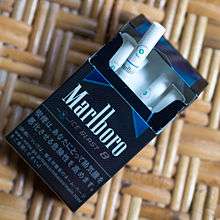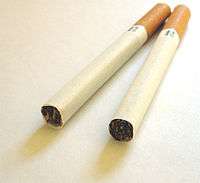Menthol cigarette
A menthol cigarette is a cigarette flavored with the compound menthol, a substance which triggers the cold-sensitive nerves in the skin without actually providing a drop in temperature.
Origins and history
Menthol cigarettes were first developed by Lloyd "Spud" Hughes of Mingo Junction, Ohio in 1924,[1] though the idea did not become popular until the Axton-Fisher Tobacco Company acquired the patent in 1927, marketing them nationwide as "Spud Menthol Cooled Cigarettes". Spud brand menthol cigarettes went on to become the fifth most popular brand in the U.S. by 1932,[2] and it remained the only menthol cigarette on the market until the Brown & Williamson Tobacco Company created the Kool brand in 1933.
For over two decades, Kools were the only significant menthol cigarette brand in the United States, with a market share that never got much above 2%. Their advertisements focused on "throat comfort" and the medicinal properties of menthol, and some ads even suggested occasional use: "In between the others, rest your throat with Kools."[3]
R.J. Reynolds Company launched the first menthol filter-tip cigarettes in 1956 under the Salem brand.[2] Less heavily mentholated than Kools, Salems were positioned as an all-purpose cigarette, and captured 0.8% market share within their first year. Other tobacco producers, seeing the success of Salem, soon introduced their own mentholated filter cigarettes: Lorillard with Newport in 1957 and Spring in 1959; Philip Morris with Alpine in 1959; and Brown & Williamson with Belair in 1960.[3]
Design and manufacture

Menthol cigarettes are constructed similarly to non-mentholated cigarettes, with menthol added at any of several stages during the manufacturing process. Menthol may be derived from distilled corn mint oil, or produced synthetically.[4] While trace amounts of menthol may be added to non-mentholated cigarettes for flavor or other reasons, a menthol cigarette typically has at least 0.3% menthol content by weight. Lower-tar menthol cigarettes may have menthol levels up to 2%, in order to keep menthol delivery constant despite the filtration and ventilation designs used to reduce tar.[4]
A recent innovation has been to include a small capsule in or near the filter which can be crushed to release additional menthol or other flavouring solutions. During the smoking of a cigarette the menthol delivery depletes noticeably, but this technology allows the smoker to increase the menthol delivery at a chosen point to sustain or enhance the menthol 'feel'. The capsules can contain any flavourings but are primarily menthol.[5]
Compared to tobacco blends for non-mentholated cigarettes, a menthol cigarette will tend to have more flue-cured than burley tobacco, and less oriental tobacco.[4]
Use and popularity
Menthol cigarette usage varies widely by country. They are most popular in the Philippines, where they account for over 60% of total cigarette sales.[6]
United States
In the United States, menthols comprise about 30% of the total cigarette market.[7] Menthol cigarettes are purchased disproportionately by African-American smokers, with 80% of African-American smokers consuming menthol cigarettes primarily.[8][9]
A 2010 study by the Substance Abuse and Mental Health Services Administration indicates that 33.7% of smokers use menthol cigarettes, compared to 31% in 2004. Much of the increase comes from young people.[10]
A Federal Trade Commission report released September 21, 2012 said menthol cigarettes had gone from 27 percent in 2008 to 22 percent in 2010.[11]
Regulation
Brazil
In March 2012, Brazil became the first country to outlaw flavoured cigarettes, and menthol cigarettes are also included in the ban.[12]
Europe
On 21 June 2013, EU health ministers agreed on a directive to ban menthol cigarettes; this decision might be implemented within three-and-a-half years.[13] In response, the former German chancellor Helmut Schmidt, 94, was reported to have hoarded 200 cartons of his preferred menthol cigarette brand in his house.[14]
On October 8, 2013 the European Parliament agreed by voting to ban menthol and other flavoured cigarettes as of 2022.[15]
United States
Although the use of menthol in ointments and cough drops is regulated by the Food and Drug Administration (FDA) in the United States of America, regulation of cigarettes was removed from their purview in 2000 by the Supreme Court in a 5–4 ruling, FDA v. Brown & Williamson Tobacco Corp.[16] In October 2009, the United States Congress passed the Family Smoking Prevention and Tobacco Control Act, which gave the FDA the authority to regulate tobacco products and ban flavor additives, although the act contained an exception for menthol.
On March 18, 2011, the Tobacco Products Scientific Advisory Committee (an advisory panel to the FDA) concluded that removing menthol cigarettes from the market would benefit public health in the United States, but stopped short of recommending that the Food and Drug Administration take any specific actions, like restricting or banning the additive.[17] In response, the tobacco industry released a report to the FDA changed focus subject by claiming menthol cigarettes are no riskier than regular cigarettes and should not be regulated differently.[18]
A progress report on panel findings was expected from the FDA in July 2011.[17]
Opposition to proposed ban
Several Black advocacy groups have voiced opposition to a proposed ban on menthol in cigarettes. The Congress of Racial Equality, the National Black Chamber of Commerce, the National Organization of Black Law Enforcement Executives, and the National Black Police Association have urged the FDA to reject a ban on mentholated cigarettes due to concerns that banning mentholated cigarettes could spur an illicit market for the outlawed products in minority communities.[19][20][21]
Groups representing law enforcement officers also oppose the ban. The Law Enforcement Alliance of America and the National Troopers Coalition have urged the FDA to consider the impact a ban on menthol cigarettes would have on tobacco smuggling.[22]
The proposed menthol ban also saw opposition from organized labor. In December 2010, workers from the Bakery, Confectionery, Tobacco Workers and Grain Millers International Union protested outside a meeting between FDA officials and industry representatives in Raleigh, North Carolina, arguing that a menthol ban would cost many workers their jobs.[23]
Additionally, the National Association of Convenience Stores opposes the ban based on menthol cigarettes accounting for 4% of their sales.[24]
Health impact
The risk of lung cancer is no different for menthol cigarettes compared to regular cigarettes.[25]
Menthol cigarettes have been shown to inhibit nicotine metabolisation, leading to increased systemic nicotine exposure.[26]
References
- ↑ "Process of Treating Cigarette Tobacco". United States Patent Office.
- 1 2 McNichols, Tom (25 March 2011). "Mint that Kills: The Curious Life of Menthol Cigarettes". The Atlantic. Retrieved 18 July 2011.
- 1 2 Market Science Associates. "The Growth of Menthols: 1933–1977".
- 1 2 3 "Characterization of Menthol: History and Design of Menthol Cigarettes" (PDF). Retrieved 11 April 2013.
- ↑ "Menthol Capsules in Cigarette Filters - Increasing the Attractiveness of a Harmful Product" (PDF). Tobacco Prevention and Tobacco Control. German Cancer Research Center, Heidelberg. 2012.
- ↑ "Epidemiology of Menthol Cigarette Use". U.S. National Library of Medicine. February 2004.
- ↑ "Lorillard, Inc 2012 Form 10-K, p. 40". U.S. Securities and Exchange Commission. Retrieved 8 April 2013.
- ↑ Rubin, Rita (2009-09-27). "Exclusion of menthol cigarettes in ban worries health experts". USA Today. Retrieved 2010-05-12.
- ↑ "Harvard Researchers Gather More Evidence Implicating Menthol in Health Disparities Between White and Black Smokers". Harvard School of Public Health. August 18, 2005.
- ↑ "National Survey on Drug Use and Health". Substance Abuse and Mental Health Services Administration. November 18, 2011.
- ↑ Craver, Richard (2012-09-25). "Reynolds to offer more menthol versions of Pall Mall cigarettes". Winston-Salem Journal.
- ↑ "Brazil bans flavoured tobacco". WHO Framework Convention on Tobacco Control.
- ↑ "EU agrees ban on menthol cigarettes". RTÉ. 21 June 2013.
- ↑ "Ex-Chancellor 'hoards 38,000 cigarettes'". The Local. 9 July 2013.
- ↑ "EU bans menthol, targets e-cigarettes". Jakarta Post. October 9, 2013.
- ↑ "FDA V. BROWN & WILLIAMSON TOBACCO CORP. (98-1152)". United States Supreme Court.
- 1 2 Wilson, Duff (18 March 2011). "Advisory Panel Urges F.D.A to Re-examine Menthol in Cigarettes". The New York Times.
- ↑ "Tobacco Makers Fight Menthol Rules". Associated Press. 18 March 2011.
- ↑ "Much heated puffing among minority groups over menthol cigarette ban". Los Angeles Times. 18 October 2010.
- ↑ Rubin, Rita (14 March 2011). "FDA weighs ban on Newports, other menthol cigarettes". USA Today.
- ↑ Lee, Jessie (24 March 2011). "Banning menthol cigarettes will create contraband market". Indianapolis Recorder.
- ↑ "National Troopers Coalition Applauds FDA Consideration of New Black Market Tobacco Study". PR Newswire. 18 November 2010.
- ↑ "NC Union Says FDA Menthol Ban Would Hurt Workers". Associated Press. 8 December 2010.
- ↑ Zajac, Andrew (18 March 2011). "Tobacco industry brushes off call for FDA restrictions on menthol cigarettes". Los Angeles Times.
- ↑ Lee, PN (April 2011). "Systematic review of the epidemiological evidence comparing lung cancer risk in smokers of menthol and regular cigarettes". BMC Pulmonary Medicine. 11 (18). doi:10.1186/1471-2466-11-18. PMC 3103484
 . PMID 21501470.
. PMID 21501470. - ↑ Benowitz, Neal; Herrera, Brenda; Jacob, Peyton (2004). "Mentholated Cigarette Smoking Inhibits Nicotine Metabolism". The Journal of Pharmacology and Experimental Therapeutics. 310 (3): 1208–15. doi:10.1124/jpet.104.066902. ISSN 0022-3565. PMID 15084646.
External links
- FTC Cigarette Report for 2002
- FDA Milestones
- Menthol vs. Nonmenthol Cigarettes: Effects on Smoking Behavior
- Menthol Cigarette Smoking in African Americans and whites
- Menthol Cigarette Brands made in Europe
- Preliminary Scientific Evaluation of the Possible Public Health Effects of Menthol versus Nonmenthol Cigarettes Food and Drug Administration
- UCSF Tobacco Industry Videos Collection
